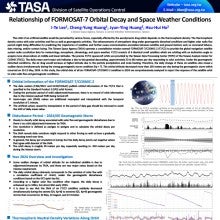Relationship of FORMOSAT-7 Orbital Decay and Space Weather Conditions
I-Te
Lee
Taiwan Space Agency, Taiwan
Poster
The orbit of an artificial satellite would be perturbed by various forces, especially affected by the aerodynamic drag which depends on the thermospheric density. The thermospheric density varies with solar activities and flux as well as geomagnetic activities. The enhancements of atmospheric drag under geomagnetic disturbed conditions and higher solar radio flux period might bring difficulties for predicting the trajectories of satellites and further cause communication anomalies between satellite and ground stations such as command failures, data missing, and/or contact losing. The Taiwan Space Agency (TASA) operates a constellation mission named FORMOSAT-7/COSMIC-2 (F7/C2) to provide the global navigation satellite system radio occultation data for meteorology, ionosphere, climatology, and space weather. F7/C2 consists of 6 identical small satellites which are orbiting with an inclination angle to acquire more observations at middle and lower latitudes. The precise F7/C2 spacecraft orbits are provided by the Taiwan Data Processing Center (TDPC) of the Taiwan Analysis Center for COSMIC (TACC). The daily mean semi-major axis indicates a day-to-day gradual descending, approximately 50 to 80 meters per day responding to solar activities. Under the geomagnetic disturbed conditions, the air drag would increase at higher latitude due to the particle precipitation and Joule heating. Therefore, the daily change of these six satellites also reveal a sudden decay simultaneously during the strong geomagnetic storm condition (Kp > 7). The orbital altitude decreased more than 100 meters per day during the geomagnetic storm which occurred on 10-12 May, 2024. In this study, the orbital data of all six FORMOSAT-7/COSMIC-2 satellites in 2024 are comprehensively analyzed to report the response of the satellite orbit to solar radio flux and geomagnetic conditions.

Poster PDF
Poster category
Ionosphere and Thermosphere Research and Applications
Meeting homepage